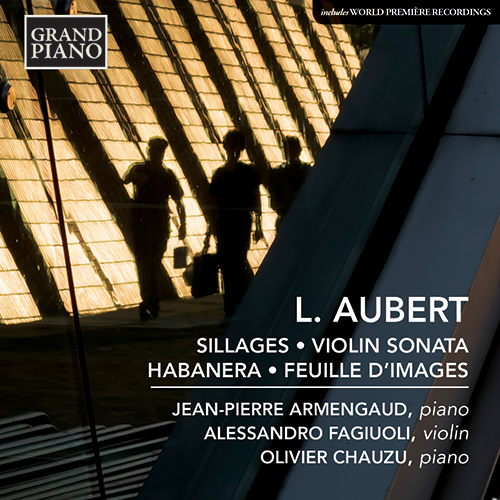
About this Release
AUBERT, LOUIS (1877–1968)
Sillages • Violin Sonata • Habanera • Feuille d’Images
- Jean-Pierre Armengaud, piano
- Olivier Chauzu, piano
A pupil of Fauré, Louis Aubert moved in the same circles as Ravel, Debussy, Koechlin and others and was considered in his day to be one of the most original French composers. With its evocatively impressionistic images of seascapes, the night and Spain, Sillages is amongst the most significant French piano works of the early 20th century. The intensely expressive and impassioned Violin Sonata is Aubert’s only large-scale work in abstract Classical form and the distinctive Feuille d’images is a varied collection of educational pieces. The fiery Habanera, Aubert’s most frequently performed orchestral work, is heard in the composer’s own transcription for piano four hands.
This recording was made on both modern and period instruments: Piano Steinway tuning 442; Violin Eugenio Degani, 1880
Tracklist
|
Sillages, Op. 27 (1913) (00:22:23 )
|
|
1
No. 1. Sur le rivage (00:08:28)
|
|
2
No. 2. Socorry (00:06:54)
|
|
3
No. 3. Dans la nuit (00:07:00)
|
|
Violin Sonata (1927) (00:23:00 )
|
|
4
No. 1. Anime * (00:08:19)
|
|
5
No. 2. Lent et tres expressif * (00:08:43)
|
|
6
No. 3. Assez anime * (00:06:10)
|
|
7
Habanera (version for piano 4 hands) (1918) * (00:08:23)
|
|
Feuille d'Images (1930) (00:14:00 )
|
|
8
No. 1. Confidence: Lent et grave * (00:02:51)
|
|
9
No. 2. Chanson de route: Avec entrain * (00:02:15)
|
|
10
No. 3. Serenade: Allegretto * (00:03:01)
|
|
11
No. 4. Des pays lointains…: Assez lent * (00:03:27)
|
|
12
No. 5. Danse de l'ours en peluche: Goguenard et pesant * (00:02:47)
|
The Artist(s)
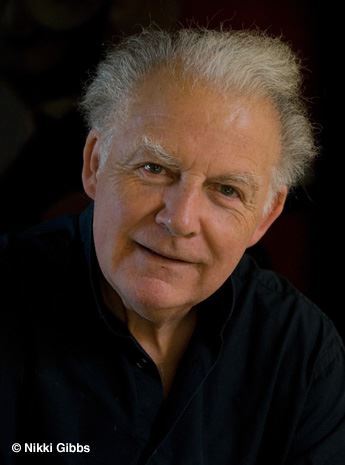 Jean-Pierre Armengaud is considered a leading interpreter of French music and a specialist in impressionist and expressionist repertoire, and is renowned for his ‘fluidly supple playing, his round and mellow tone’ (Classica). He has recorded several complete collections, of piano music by Debussy, Satie, Roussel, Poulenc, Dutilleux and Denisov. Armengaud has appeared in major concert halls around the world, performing in over 40 countries. His albums for Naxos and Grand Piano feature music by Debussy, Roussel, Poulenc, Aubert, d’Indy and others, and he has a particular interest in Henri Dutilleux. He has been director for musical programming at Radio France and is associate professor at the ParisSorbonne University and professor emeritus at the University of Évry Val d’Essonne at Paris-Saclay University.
Jean-Pierre Armengaud is considered a leading interpreter of French music and a specialist in impressionist and expressionist repertoire, and is renowned for his ‘fluidly supple playing, his round and mellow tone’ (Classica). He has recorded several complete collections, of piano music by Debussy, Satie, Roussel, Poulenc, Dutilleux and Denisov. Armengaud has appeared in major concert halls around the world, performing in over 40 countries. His albums for Naxos and Grand Piano feature music by Debussy, Roussel, Poulenc, Aubert, d’Indy and others, and he has a particular interest in Henri Dutilleux. He has been director for musical programming at Radio France and is associate professor at the ParisSorbonne University and professor emeritus at the University of Évry Val d’Essonne at Paris-Saclay University. 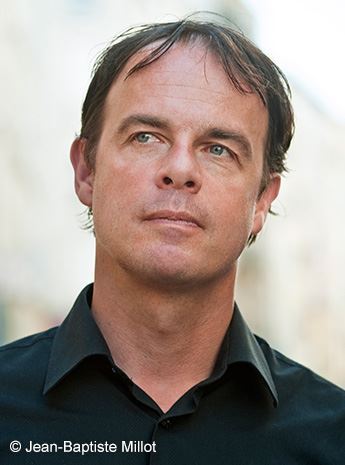
Pianist Olivier Chauzu trained at the Conservatoire National Supérieur de Musique in Paris, where he obtained First Prize for Piano followed by First Prize in Chamber music, studying under Gabriel Tacchino, Théodore Paraschivesko, Jean-Claude Pennetier and György Sebök. He was also a pupil of Leon Fleisher, Vitaly Margoulis and Dimitri Bashkirov before further studies at the Banff School of Fine Arts in Alberta, Canada. A prizewinner in Barcelona’s 1989 Maria Canals International competition, he went on to be awarded the Prix Claude Debussy in the Yvonne Lefébure competition in Saint-Germain-en-Laye the following year.
The Composer(s)
 Louis Aubert, like his contemporaries Joseph Guy Ropartz (1865–1955) and Paul Le Flem (1881–1984), was of Breton origins: he was born on 19th February in Paramé, today part of Saint-Malo. Even as a child Aubert had an excellent ear for music—he was a gifted pianist and sang as a treble chorister in the main churches of Paris. His talents were noted by one of his first teachers, Charles Steiger, who soon brought him to the attention of Albert Lavignac, a professor at the Paris Conservatoire. Aubert went on to study harmony with Lavignac, discovering the great composers in the history of music along the way. He also studied piano with Antoine-François Marmontel and, later, Louis Diémer. Aubert had begun studying composition with Fauré in 1893, and by 1896 his fellow students also included Maurice Ravel, Florent Schmitt, George Enescu, Charles Koechlin, Jean Roger-Ducasse, Paul Ladmirault and Émile Vuillermoz.
Louis Aubert, like his contemporaries Joseph Guy Ropartz (1865–1955) and Paul Le Flem (1881–1984), was of Breton origins: he was born on 19th February in Paramé, today part of Saint-Malo. Even as a child Aubert had an excellent ear for music—he was a gifted pianist and sang as a treble chorister in the main churches of Paris. His talents were noted by one of his first teachers, Charles Steiger, who soon brought him to the attention of Albert Lavignac, a professor at the Paris Conservatoire. Aubert went on to study harmony with Lavignac, discovering the great composers in the history of music along the way. He also studied piano with Antoine-François Marmontel and, later, Louis Diémer. Aubert had begun studying composition with Fauré in 1893, and by 1896 his fellow students also included Maurice Ravel, Florent Schmitt, George Enescu, Charles Koechlin, Jean Roger-Ducasse, Paul Ladmirault and Émile Vuillermoz. Reviews

“In his dazzling triptych Sillages, Aubert reveals himself as Ravel’s “brother in art”...Louis Aubert is our “other Ravel”. Unjustly neglected, it is essential to rediscover his music with this album.” – Classica
“The distinguished pianist, Jean-Pierre Armengaud, writes enthusiastically of Aubert in his programme note, an admiration that continues in his performances.” – David’s Review Corner

“… Jean-Pierre Armengaud’s playing possesses a fluid flexibility that is perfectly adapted to these sound waves…His profoundly poetic interpretation demonstrates an intimate knowledge of the score and easily elevates him high above his two great predecessors Christina Ariago (Brilliant) and Marie-Catherine Girod (Opes 3D)… ” – Classica
“This music really deserves to be recognized. Louis Aubert writes with a spontaneity coupled with a concern for balance between discourse, sound and form....This CD obviously represents a long and exceptional effort to recover the spirit and the heart of this music that touches our present sensibilities to find a deep link between yesterday and today.” – CultureMag

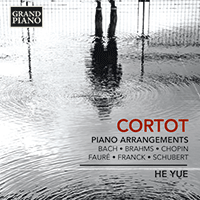
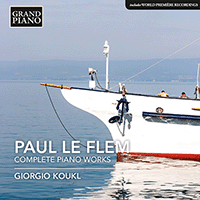
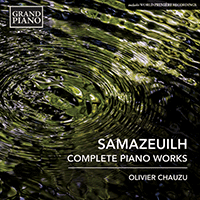
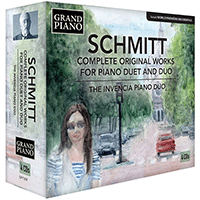
 Grand Piano has gained a reputation for producing high quality recordings of rare keyboard gems. Dedicated to the exploration of undiscovered piano repertoire, the label specialises in complete cycles of piano works by many lesser-known composers, whose output might otherwise have remained unknown and unrecorded.
Grand Piano has gained a reputation for producing high quality recordings of rare keyboard gems. Dedicated to the exploration of undiscovered piano repertoire, the label specialises in complete cycles of piano works by many lesser-known composers, whose output might otherwise have remained unknown and unrecorded.






